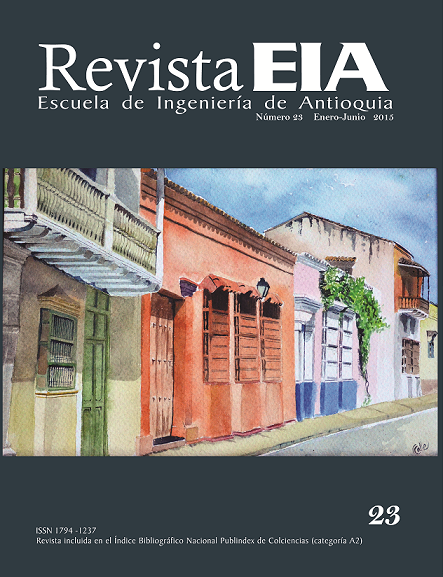RELACIÓN ENTRE LA LONGITUD DEL MIEMBRO RESIDUAL Y LA DISTRIBUCIÓN DE ESFUERZOS SOBRE EL MUÑÓN PARA AMPUTADOS TRANSFEMORALES
RELACIÓN ENTRE LA LONGITUD DEL MIEMBRO RESIDUAL Y LA DISTRIBUCIÓN DE ESFUERZOS SOBRE EL MUÑÓN PARA AMPUTADOS TRANSFEMORALES


This work is licensed under a Creative Commons Attribution-NonCommercial-NoDerivatives 4.0 International License.
Copyright statement
The authors exclusively assign to the Universidad EIA, with the power to assign to third parties, all the exploitation rights that derive from the works that are accepted for publication in the Revista EIA, as well as in any product derived from it and, in in particular, those of reproduction, distribution, public communication (including interactive making available) and transformation (including adaptation, modification and, where appropriate, translation), for all types of exploitation (by way of example and not limitation : in paper, electronic, online, computer or audiovisual format, as well as in any other format, even for promotional or advertising purposes and / or for the production of derivative products), for a worldwide territorial scope and for the entire duration of the rights provided for in the current published text of the Intellectual Property Law. This assignment will be made by the authors without the right to any type of remuneration or compensation.
Consequently, the author may not publish or disseminate the works that are selected for publication in the Revista EIA, neither totally nor partially, nor authorize their publication to third parties, without the prior express authorization, requested and granted in writing, from the Univeridad EIA.
Show authors biography
Resumen
Se construyeron cinco modelos de prótesis transfermorales compuestos por socket, muñón y fémur, se definió el porcentaje de miembro residual para cada individuo. Cada modelo correspondió a un voluntario al cual se le tomaron moldes de muñón y socket y tomografías del muñón. Las partes se digitalizaron en un modelo CAD y el ensamble se exportó a un software de análisis por elementos finitos. Se realizó un análisis de la marcha y se establece que las condiciones más críticas para las fuerzas de reacción suceden en la fase inicial de apoyo. Para esta fase se formuló un modelo estático y se calcularon las cargas sobre el socket a partir de las fuerzas de reacción en el piso.Se simularon en el software la fase de postura del socket, la fase de relajación y la fase final de carga, obteniéndose los valores y distribuciones de presiones y esfuerzos cortantes en la superficie del muñón para la fase de carga y los esfuerzos principales de von Mises para el fémur. Estos valores se relacionaron con los porcentajes de miembro residual para buscar relaciones y tendencias. Se encontró que existe una relación entre el porcentaje de miembro residual y las presiones en la superficie del muñón.
Abstract
Five transfermoral prosthesis models compounded by socket, stump and femur were built. The percentage of residual limb for each individual was defined. Each model appertained to a volunteer whom molds stump and stump socket and scans were taken. The parts were digitized into a CAD model and the assembly was exported to finite element analysis software. Gait analysis was performed and it is established that the most critical conditions for the forces of reaction occurs in the initial phase of support. For this phase, a static model was formulated. Likewise loads on the socket were calculated taking into account the reaction forces on the ground. The stance phase of the socket, the relaxation phase and the final phase load were simulated by the software, acquiring values and distributions of pressure and shear forces on the stump surface to the loading phase and the main von Mises stresses for the femur. These values were related to the percentage of residual limb in order to find relationships and trends. It was found that a relationship exists between the percentage of residual limb and the pressures on the stump surface.
Resumo
Foram construídos cinco modelos de prótese transfemorais compostos socket, fêmur e coto, foi definido o percen-tual de membro residual para cada um. Cada modelo corresponde a um voluntário para o qual se tomou moldes de coto, socket y tomografias do coto. As partes foram digitalizadas em um modelo de CAD e a montagem foi exportado para o software de análise de elementos finitos. A análise da marcha foi realizada e afirma que as condições mais críticas para as forças de reação ocorrem na fase inicial de apoio. Foi formulado para esta fase de um modelo estático e foram calcula- das as cargas o socket a partir das forças de reação no terreno.Foram simuladas no software a fase de apoio do socket, a fase de relaxamento e a fase final de carga, produzindo valores e distribuições de pressão e tensões de cisalhamento na superfície do coto para a fase de carregamento e os principais esforços de von Mises para o fêmur. Estes valores foram relacionados com os percentuais de membro residual para encontrar relações e tendências. Verificou-se que existe uma relação entre a percentagem do membro residual e as pressões sobre a superfície do coto.
Article visits 304 | PDF visits 134
